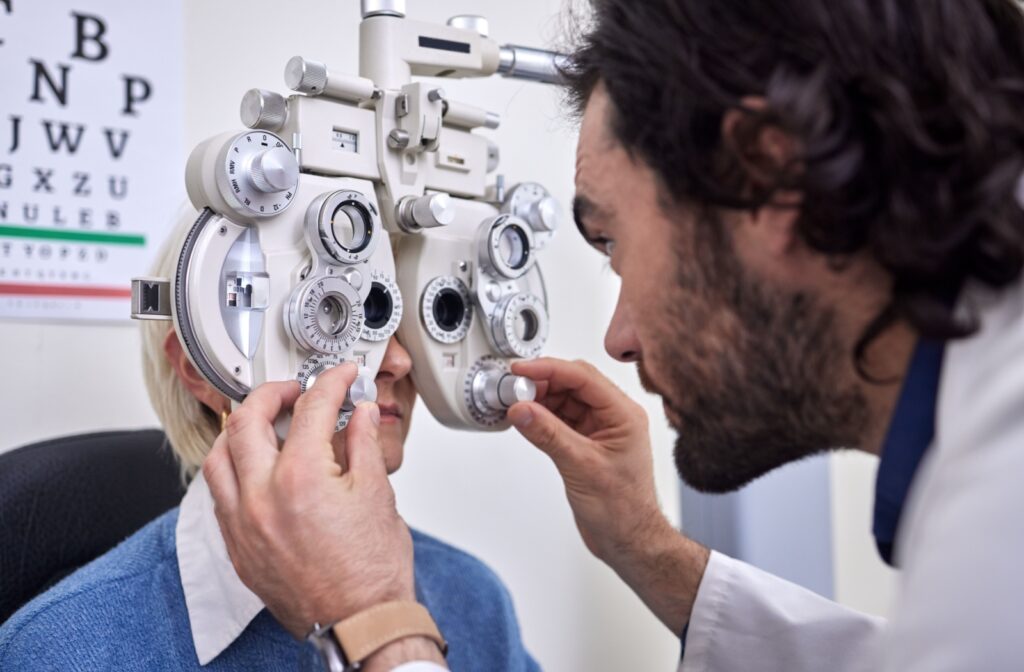Understanding insurance benefits can feel like a chore, but learning how vision insurance works doesn’t have to be complicated. When it comes to your family’s health, clear information helps you make confident decisions. This is especially true for eye care, where regular check-ups can support a lifetime of healthy vision.
Vision insurance primarily covers routine, preventative eye care like annual exams and prescription eyewear to help you maintain your eye health. It’s designed to make consistent care more accessible and affordable for you and your loved ones.
At Total Vision, we accept most vision insurances, including VSP. We’re now in-network with VSP, so all VSP members can use their vision benefits at any Total Vision location.
How Vision Insurance Plans Work
Vision insurance helps you cover the costs of routine eye care, prescription eyewear, and other vision-related services. You pay a regular premium, and in return, the plan pays for or discounts certain benefits. This makes it easier for your family to budget for regular check-ups with a local eye care provider.
The Role of Preventative Eye Care
These plans focus on preventative care to help maintain your eye health and provide early detection of potential vision issues. Regular exams are a key part of your overall wellness, as they can detect over 270 different health conditions. Exams also give us a chance to catch small problems before they grow into bigger concerns.
Copays, Allowances, & Frequencies
Most plans include a small copay you pay at the time of your exam. For glasses or contacts, your plan often provides a set dollar amount, known as an allowance. Benefits for exams, frames, and lenses are typically available on a set schedule, such as once every 12 or 24 months.
Standard Services Covered by Your Plan
While every plan is different, most vision insurance offers coverage for a core set of services and products. Knowing what’s usually included can help you plan your appointments.
Annual Comprehensive Eye Exams
The foundation of any vision plan is the yearly eye exam. During this visit, your optometrist checks your vision sharpness and looks for common eye health issues. Regular exams are about more than just a new prescription; they’re a snapshot of your current eye health.
Prescription Glasses Lenses
Your plan typically covers standard lenses needed to correct your eyesight, including single-vision, bifocal, or trifocal options. Some basic lens features like scratch-resistant coatings may also be included. This helps you get the functional eyewear you need.
Frames & Contact Lenses
After your exam, you can use your plan’s allowance toward a new pair of frames. If you prefer contact lenses, many plans offer an allowance that can be used for your supply of contacts instead of glasses. This flexibility allows you to choose the option that fits your lifestyle.

What Vision Insurance May Not Cover
It’s helpful to know that vision insurance is designed for routine eye care and not for medical treatments. This is an important distinction, as your regular health insurance often covers medical eye problems. Understanding this difference can help you navigate your benefits correctly.
Cosmetic or Elective Procedures
Procedures considered elective or cosmetic are usually not part of a vision plan. This can include services like LASIK or other types of refractive surgery. You can always ask about these options, but they typically fall outside of standard coverage.
Major Medical Eye Conditions
Your medical insurance—not your vision plan—is used for the diagnosis and treatment of eye diseases or injuries. This approach helps you receive care for specific medical needs. This includes conditions such as:
- Cataracts
- Glaucoma
- Diabetic retinopathy
- Eye infections or injuries
Lens Upgrades & Premium Frames
While a plan covers the basics, certain upgrades often come with out-of-pocket costs. These can include anti-glare coatings, progressive lenses, or designer frame brands that exceed your plan’s allowance. However, you can always apply your allowance and pay the difference for these more premium features.
Vision Benefits for Your Whole Family
Vision needs change throughout life, and a good plan supports everyone in your family, from young children to seniors. Regular check-ups are important at every age to address different developmental stages and life events. Your benefits are there to help you every step of the way.
Eye Care for Children
For children, routine eye exams help detect vision problems that could affect their development and performance in school. Early and consistent eye care can support their learning journey. Many plans offer benefits tailored to younger members of the family.
Vision Needs for Adults & Seniors
As you get older, your vision changes. Adults and seniors can use their benefits for updated prescriptions for glasses or bifocal contacts. Exams also screen for conditions like age-related eye conditions, which is a key part of long-term health monitoring.
How to Use Your Vision Benefits
Using your vision plan can be done in a few simple steps. With a little preparation, you can make the process smooth and straightforward. The goal is to get you the care you need without any hassle.
Find a Provider in Your Network
The first step is to locate an eye doctor that accepts your plan. It’s easy to find a list of eye doctors across California and in your area through your insurance provider’s website. Choosing an in-network provider helps you receive your full benefits.
Schedule Your Appointment
Once you find a local eye care provider, you can call to schedule an exam. Have your insurance information ready so their office can confirm your eligibility and benefits before your visit. This helps your appointment go smoothly from the start.
Your vision insurance is a valuable tool for maintaining your family’s eye health. By covering routine exams and eyewear, you can take a proactive approach to your vision. At Total Vision, we partner with our network of eye care providers to help you understand and use your benefits.
Take the next step in caring for your vision and schedule a visit with your local eye care provider. We’re here to help you see your world clearly.



